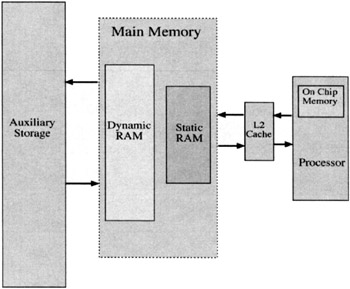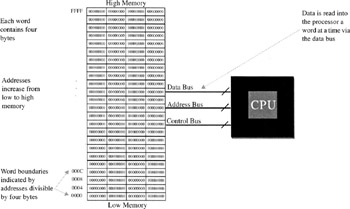What Is A Program?
Memory Organization
Modern computer systems have similar memory organizations and as a programmer you should be aware of how computer memory is organized and accessed. The best way to get a good feel for how your computer works is to poke around in memory and see what’s in there for yourself. This section provides a brief introduction to computer memory concepts to help get you started.
Memory Basics
A computer’s memory stores information in the form of electronic voltages. There are two general types of memory: volatile and non-volatile. Volatile memory will lose any information stored there if power is removed for any length of time. Main memory and cache memory, two forms of Random Access Memory (RAM), are examples of volatile memory. Read Only Memory (ROM) and auxiliary storage devices such as CD ROMs, DVDs, hard disk drives, memory sticks, floppy disks, and tapes, are examples of non-volatile memory.
Memory Hierarchy
Computer systems contain several different types of memory. These memory types range from slow and cheap to fast and expensive. The proportion of slow cheap memory to fast expensive memory can be viewed in the shape of a pyramid commonly referred to as the memory hierarchy as is shown in figure 4-6.

Figure 4-6: Memory Hierarchy
The job of a computer-system designer, with regards to memory subsystems, is to make the whole computer perform as if all the memory were fast and expensive. Thus they utilize cache memory to store frequently used data and instructions and buffer disk reads to memory to give the appearance of faster disk access. Figure 4-7 shows a block diagram of the different types of memory used in a typical computer system.

Figure 4-7: Simplified Memory Subsystem Diagram
During program execution, the faster cache memory is checked first for any requested data or instruction. If it’s not there, a performance penalty is extracted in the form of longer overall access times required to retrieve the information from a slower memory source.
Bits Bytes, Words
Program code and data are stored in main memory as electronic voltages. Since I’m talking about digital computers the voltages levels represent two discrete states depending on the level. Usually low voltages represent no value, off, or 0, while a high voltage represents on, or 1.
When program code and data is stored on auxiliary memory devices, electronic voltages are translated into either electromagnetic fields (tape drives, floppy and hard disks) or bumps that can be detected by laser beam (CDs, DVDs, etc.).
Bit
The bit represents one discrete piece of information stored in a computer. On most modern computer systems bits cannot be individually accessed from memory. However, after the byte to which a bit belongs is loaded into the processor the byte can be manipulated to access a particular bit.
Byte
A byte contains 8 bits. Most computer memory is byte addressable, although as processors become increasingly powerful and can manipulate wider memory words, loading bytes by themselves into the processor becomes increasingly inefficient. This is the case with the G4 processor and for that reason the fastest memory reads can be done a word at a time.
Word
A word is a collection of bytes. The number of bytes that comprise a word is computer-system dependent. If a computer’s data bus is 32 bits wide and its processor’s registers are 32 bits wide, then the word size would be 4 bytes long. (32 bits 18 bits=4 bytes) Bigger computers will have larger word sizes. This means they can manipulate more information per unit time than a computer with a smaller word size.
Alignment And Addressability
You can expect to find your computer system’s memory to be byte addressable and word aligned. Figure 4-8 shows a simplified diagram of a main memory divided into bytes and the different buses connecting it to the processor. In this diagram the word size is 32 bits wide.

Figure 4-8: Simplified Main Memory Diagram
The memory is byte addressable in that each byte can be individually accessed although the entire word that contains the byte is read into the processor. Data in memory can be aligned for efficient manipulation. Alignment can be to natural or some other boundary. For example, on a PowerPC system, contents of memory assigned to instances of structures is aligned to natural boundaries meaning a one-byte data element will be aligned to a one-byte boundary. A two-byte element would be aligned to a two-byte boundary. Individual data elements not belonging to structures are usually aligned to four-byte boundaries. (Note: The term “structure” denotes a C or C++ structure. In Java there is no equivalent and the Java virtual machine prevents direct memory manipulation.)
EAN: 2147483647
Pages: 452